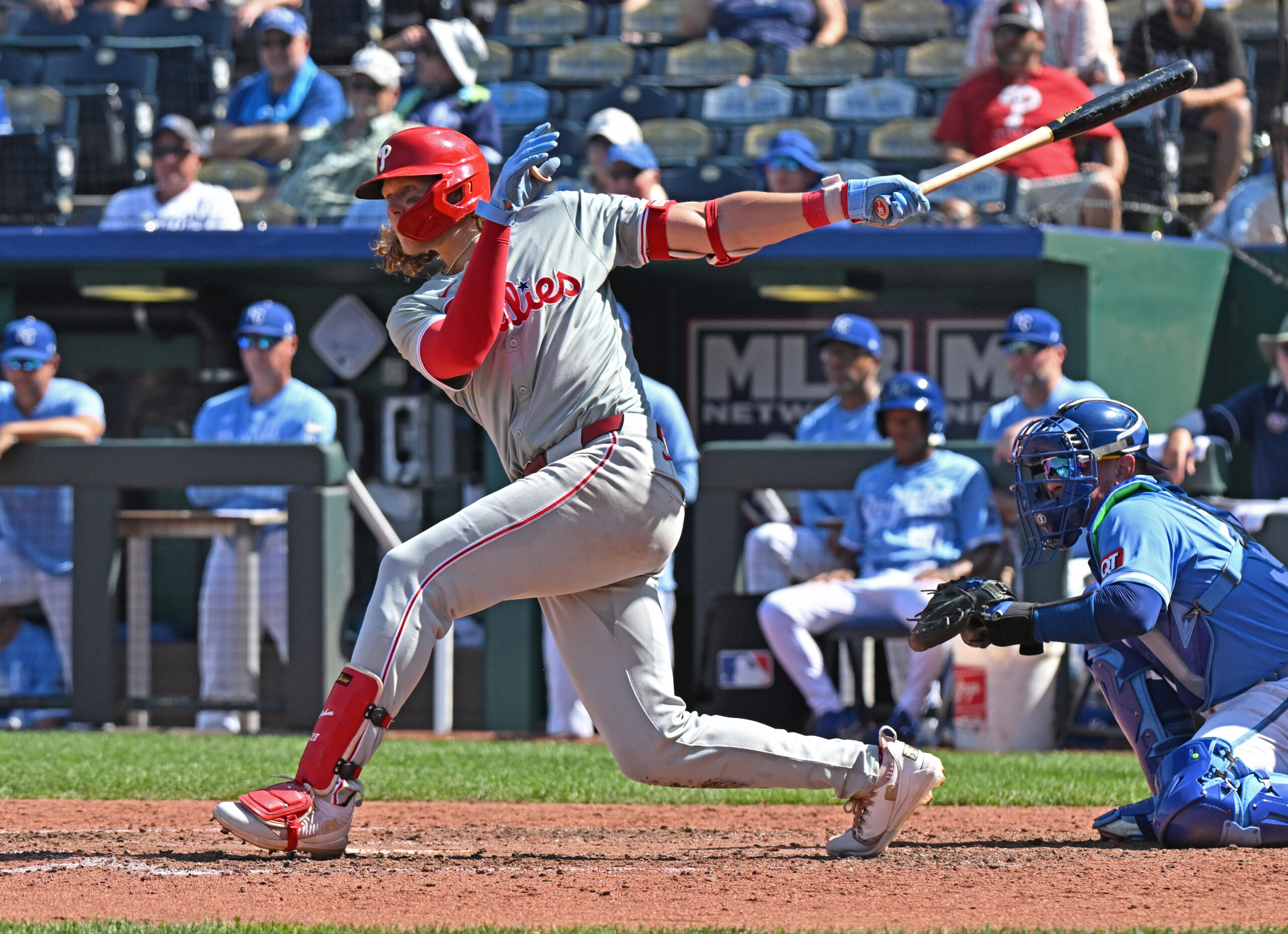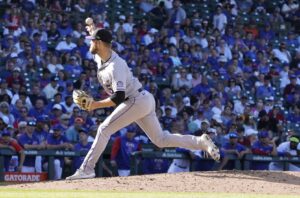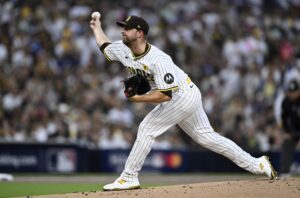Two of the four division series have concluded, capping off a thrilling week of playoff baseball. The New York Yankees bested the Kansas City Royals three games to one, while the New York Mets shocked the Philadelphia Phillies by the same margin. On the one hand, we can ask whether we’re going to see another subway series.
On the other hand, as for the defeated, the only option they have now is to figure out what went wrong and how to fix them. Free agency doesn’t start until November, but this doesn’t mean they can’t look at their organizational depth for answers to their questions. Questions such as, “Why did our bats get so cold?” or “How did our pitching collapse so badly?”
While there are only two losers so far from the second round of the MLB playoffs, it’s a perfect time for them to take advantage of their early exit and scrutinize their team. Here are two prospects from each losing team that could help them in 2025.
Phillies
1) RHP Andrew Painter (#32 Overall Prospect)
2024: Did Not Pitch (Tommy John Surgery)
2022 (Three Teams): 6-2; 103 2/3 IP, 1.56 ERA, 67 hits to 25 BB (0.887 WHIP), 5 HR, 155 K, .181 OBA
The Phillies pitching staff, especially their bullpen, was awful during the division series. The good news is that Zack Wheeler and Ranger Suarez can absolutely play good baseball in October. The bad news is that the rest of the staff completely folded.
Across 11 pitchers, the Phillies sported a 5.82 earned-run average along with an ugly 1.588 WHIP. The staff sported a nearly five walks-per-nine-innings ratio, but the most disastrous number is the seven home runs they surrendered in 35.2 innings.
In March, MLB writers penned the Phillies as the best-projected bullpen in the league. They were far from that in the division series, with Matt Strahm sporting an 18 ERA and Jeff Hoffman carrying a 40.5 ERA. How do they fix this mess?
It’s not an easy answer, but Andrew Painter is the best way to go to try and begin to address this.
We previously discussed Painter in our NLDS preview article. He’s coming off Tommy John surgery and he hasn’t pitched in two years. However, his numbers before his injury were too good to ignore, even after a long time.
It needs to be reiterated that Painter had a 1.56 ERA, 0.887 WHIP, and a 14.5 strikeout rate through nine innings in 2022. He didn’t give up many walks and kept his home run rate below .5.
There is no telling how he will perform when he comes back in 2025, as Tommy John injuries are hard to come back from in full force. However, after this performance by the pitching staff, Painter’s performance will be crucial to their 2025 season. It’s no longer just about rehabbing and building arm strength, they need him to perform now.
Again, do not expect him to be on the opening day roster. The question is whether he starts out in the bullpen sometime next year. In the last article, we discussed Taijuan Walker possibly being out if Painter performed. With this recent meltdown by the staff, anyone is at risk of being removed.
2) 2B/3B Otto Kemp (#28 Organizational Prospect)
2024 (Four Teams): .285/.392/.881; 24 doubles; 9 triples; 16 home runs; 66 RBIs; 52 BB to 112 K; 20 SB
Aside from a comeback in Game two in front of their home crowd, the Phillies lineup was spotty and inconsistent. For every Nick Castellanos and Bryce Harper, Alec Bohm and Brandon Marsh followed behind. In fact, J.T. Realmuto failed to record a single hit in four games.
The team’s slash line was an uncharacteristic .186/.295/.598 in the division series, a far cry from their .257/.325/.750 overall line. Yes, they hit home runs and scored with runners at second and third, but they struck out nearly twice as often as they hit.
In fact, even with walks combined, they struck out more than they got on base in total. It’s uncharacteristic of a team that once boasted the best offense and record in baseball. Is there anyone that can help out the team’s fading hitting?
The Phillies best option, at this point, is second baseman Otto Kemp.
There is very little on Kemp, given he’s a 25-year-old low-end prospect for the Phillies. But when you look at his numbers, he is the most MLB-ready on the field.
Over the last three years in the organization, his numbers have progressively gotten better with each jump in level. He notched career highs in almost every single major statistic category, including triples with nine. He also nearly matched the number of his stolen base from last year.
Kemp has more gap power than raw power, which might be good. For a team that failed to hit .200 in the postseason, his ability to get an extra-base hit would provide the team with more opportunities to score. Combine this with the fact that he hits more than he strikes out and can garner a walk rate above 10 percent, and he becomes a cheap and quick-fix candidate for next year.
That being said, Kemp is limited to playing second and third base. The only other spots he’s played are at first, shortstop, and right field. Good luck moving anyone from their spots permanently. Kemp is best suited for a utilityman role, but his bat provides valuable worth.
Royals
1) OF Tyler Gentry (#15 Organizational Prospect)
2024 (AAA): .251/.338/.760; 24 doubles; 1 triple; 16 home runs; 59 RBIs; 53 BB to 149 K; 8 SB
Giving credit where it is due, the Royals had the honorable distinction of being a playoff team the year after losing 100 games. Bobby Witt Jr. had an MVP-caliber season, and their team led the league in having the least strikeouts while batting.
In the AL division series, however, the team sported an uninspiring .237/.278/.596 slash line while striking out 34 times. That’s a warning sign when you compare that to the fact they only had seven walks in the whole series.
In addition, the team had only six extra-base hits throughout the series, two of them home runs. The lineup needs some plate discipline and pop to get back into serious conversation.
Tyler Gentry, although not the ideal solution, could help the team with its slugging issue.
The Royals’ farm system is very weak, having been ranked among the lowest five for nearly two years. There are no easy solutions or answers within the system that scream “must-promote.” Gentry is far from this but is a formidable, temporary power solution.
Gentry has a nice blend of gap and raw power, leaning more towards gap-heavy. He’s hit 20 doubles each year in his last three seasons, but he has also hit more than 15 home runs in the same time span each year.
There is a glaring issue. Gentry’s strikeout rate has climbed from around 25% in 2022 to nearly 33% in 2024. Likewise, his walk rate has also gone down. He’s at a point where he strikes out 50% more times than he gets a hit, not ideal for a team that struggled to work the count.
The 2020 third-rounder made his debut this year but only had five plate appearances. We’ll certainly expect to see more next year, but if the recent trends are any indication, it’s not going to be an easy adjustment. Ryals fans should be happy if he transfers his gap and raw power success to the big league level.
2) LHP Noah Cameron (#12 Organizational Prospect)
2024 (Two Teams): 7-6; 128.2 IP; 3.08 ERA; 120 hits and 36 BB (1.21 WHIP); 12 HR (.9 HR/9); 149 K (11.5 K/9); .243 OBA
The starting pitching was the seasonal story of the Royals. While they didn’t strike out many players, their walk rate was just above the big-league average, and their WHIP remained steady at 1.25. They led the league in the least number of home runs surrendered with 146.
In the division series, there was a clear issue with the pitching. The team had a walk rate of around eight per nine innings. On top of that, they surrendered almost one hit per inning, ballooning their WHIP to a dismal 1.571. Whether it was advanced plate discipline by the Yankees or control issues, there were serious concerns. You can’t do that during a division series, especially when you’re going up against a good lineup.
Left-hander Noah Cameron is the next-best answer to their control and location issues.
When it comes to playing teams sporting Juan Soto and Aaron Judge, both of whom have advanced eyes, control and location are key. Cameron, despite not being a high-level ace, gives the team these two important boosts.
Cameron has been able to maintain his strikeout rate over the nine per nine innings average since being drafted. In addition, his walk rate has continued to go down, nearing being under three per nine innings. He can place the ball and generate whiffs when it matters.
The downside is that he doesn’t miss bats that often, sporting a .243 opposing batting average while surrendering 12 home runs in 2024. Thankfully, he’s kept his damage to a minimum with his high strikeout rate. He’s no Paul Skenes or Nolan Ryan, but he’s primed for a middle-reliever or setup role in 2025.
Being in Triple-A and pitching the best he has in his career, Cameron has a case to make it out of spring training on the opening day roster. It might be wise for the Royals to convert this starter into a setup man, giving you game after game of quality appearances. With his four-pitch arsenal, including a high-graded changeup, he could be a very important end-of-game bullpen asset.
Main Photo Credits: Peter Aiken-Imagn Images






